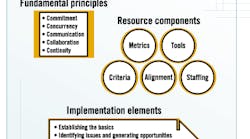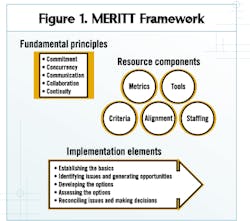Rather than incorporating environmental, health and safety (EH&S) requirements and goals at a point in the development cycle where they virtually always add costs and produce delays, experience has shown that early consideration of EH&S issues as an integral part of the design process can achieve cost savings and improve time to market. In 2001, the American Institute of Chemical Engineers (AIChE) Foundation published the results of its efforts to develop an approach for enhancing process development through earlier and better integration of EH&S reviews. The suggested approach draws on well-recognized practices embedded in inherent safety, pollution prevention, green chemistry and other EH&S paradigms. The intent is to enhance existing development processes, not to try to replace them. Thus, several critical training needs exist, including: Training focused on specific tools that process engineers and others can use in the development process to ensure EH&S issues are recognized and considered even at times when EH&S experts are not available for team input. Training that will help EH&S professionals effectively contribute to the development teams as members and/or external resources.This article provides an overview of the approach and highlights the associated training issues, as well as the enhanced opportunities for staff with such training.**Basic approachTypically, companies review and address EH&S requirements through a series of independent single-topic reviews of process designs. The AIChE Foundation outlined an approach for enhancing process development through earlier and better integration of EH&S reviews. Called MERITT (Maximizing EH&S Returns by Integrating Tools and Talents), the approach draws on critical components of inherent safety, pollution prevention, green chemistry and related paradigms through selective adoption and adaptation of existing tools, skills and knowledge resources. MERITT recognizes that early process development activities have the highest potential for leverage; that basic chemistry determines waste generation and process safety hazards; and that the application of "good ideas" late in the process life cycle can be difficult and costly.MERITT draws on the following three key concepts to achieve optimization: Driving evaluations to the earliest stage in the process. Linking successive stages and evaluations. Expanding information and knowledge exchange.Staff training on the approach and the available tools is critical to realizing the full benefit of each concept.MERITT draws on the existing best practices of organizations that are recognized leaders in developing and conducting coordinated EH&S evaluations through the use of tools and protocols that support their own programs. These tools and protocols generally are built on pollution prevention, design for the environment, inherent safety, green chemistry and/or green technology. MERITT also recognizes that the focus of most research chemists is on molecule development, not process issues, and that the lack of familiarity with EH&S paradigms can be overcome through training, tools, communication of actual improvements and access to EH&S resources.MERITT is not fundamentally new. Instead, it can be described most accurately as creative adaptation ," rethinking, reorganizing and redirecting the many pieces that already exist and work individually, but have yet to be fully integrated or coordinated. MERITT offers ways to enhance these processes through increased awareness and recognition throughout all levels of the organization ," from engineers and chemists to project managers and business leaders. It emphasizes the need to think about the various concepts at the same time, to infuse appropriate tools at the various project stages, and to put the right type of knowledge to work at the right time. New development processes are not necessarily required to accomplish this. Instead, existing processes can be expanded or adjusted. MERITT is particularly well suited to processes structured in sequential stages with fairly well defined stage gates, but it is applicable to almost any development format. The construct of MERITT is more along the lines of an enabler than that of a traditional methodology. Because many variables exist in development processes, MERITT was crafted with enough flexibility to ensure the basic approach can be tailored to accommodate different requirements.Fig. 1 shows the pieces of the framework. The implementation elements portion consists of five steps and provides a format for conducting EH&S evaluations within the construct of the development process. Fig. 2 presents a simplified diagram that represents the linkage of these five steps. It parallels a similar process that has been endorsed fairly widely for conducting pollution prevention assessments.
Some of the typical modifications that might be needed for existing processes include: The identification of minimum expectations for the involvement of EH&S expertise and reviews (i.e., applications of tools) at different stages, just as some level of cost estimate typically is required at most stages. Overview training on MERITT concepts as part of any formal or informal project management training. Specific training on MERITT tools and guidance on the means to obtain additional information, whether it is through internal resources or external Web sites, also is needed. Publication of a listing or directory of MERITT contacts and resources to assist project managers and other team members. Incorporation of MERITT-related metrics into the project management metrics and tracking system. This also will serve to reinforce the value to the engineers and scientists who are involved.Staffing and knowledge issuesIt is crucial that the right types of information, expertise and knowledge are brought to bear at the right times in the process. Availability and utilization of staff are critical in this regard. This is where the corporate and project organizational interfaces can either collide or meld. Tailoring the "who," "when," and "how" in staffing for the development process is not an insignificant task. It cuts into the territorial and cultural barriers of different organizations. In addition, such decisions also must work with the existing process development systems, assuming they are functioning properly.Traditionally, EH&S expertise is added relatively late in the process. The addition of this expertise earlier is not always feasible or desirable; therefore, other means of knowledge transfer must be included to support EH&S integration. The goal is to allow knowledge transfer to occur in a way that does not overly encumber the development process with masses of people and frequent, lengthy meetings. The complement of disciplines, experts, leaders and facilitators/coordinators involved at each step along the way, therefore, should be choreographed carefully in advance and adjusted as needed throughout the process. The same is true for the manner in which the communications and interchanges are to occur ," whether that involves meetings, teleconferences and/or other types of exchanges.Tools that bring the critical EH&S knowledge to the process development team without requiring EH&S "bodies" can be very effective. Unless the projects are very small and short-lived, some degree of structure within the project team inevitably will be required. This can be accomplished through the use of both core teams and support groups (such as environmental, health or safety specialists) in terms of staff utilization. However, traditional staffing will need to be expanded both horizontally and vertically. This includes the use of staff to accomplish better transitions between stages, effectively actualizing the five fundamental principles.ToolsDozens of tools have been developed to assist in EH&S evaluations. Roughly two dozen have been identified for potential use in supporting MERITT. These have been drawn from several sources, notably: Existing environmental, health and/or safety paradigms such as pollution prevention, green chemistry, inherent safety and design for the environment. Recent efforts in developing integrated EH&S tools. Codified process safety tools such as process hazard analyses. Widely used business analysis methodologies such as life-cycle analysis. Decision theory.These tools are grouped into three general categories for MERITT: inquiry, option generation and option evaluation/ decision support. Inquiry tools primarily are intended to identify EH&S issues and offer less help with immediate solutions. As their name implies, option generation tools help in the formulation of alternative-design concepts to address issues found with inquiry tools. Evaluation or decision-support tools focus on methods for ranking alternatives using various EH&S and cost criteria. The results typically are expressed in the form of indices or numerical rankings. The table provides examples for each category. These tools provide one way to capture EH&S knowledge and transfer it to others.
The transfer of learning is easier for some of the paradigms ," such as inherent safety and pollution prevention ," than for others. However, most chemists involved in the early stages of research programs do not have formal training in inherent safety, pollution prevention, green chemistry, etc., and most engineers do not receive training in life-cycle analysis. Thus, significant opportunity exists for MERITT to add value beyond the individual paradigms as practiced today. This value also adds to the skill base and knowledge of the members of the process development team, increasing the team members' market value by differentiating them from more traditional scientists and engineers. Training also can generate a degree of awareness, which leads not just to an environment of acceptance but also to a more proactive appeal for support throughout the organization. This requires a demonstration of the overall business value of front-end loaded EH&S integration as well as the value to individual professionals in making it happen.Using resources efficientlyThorough implementation of MERITT might require slightly more resources up front in the process development cycle, but that requirement will be more than offset by reduced resource requirements later in the development cycle ," along with significant operating cost savings. In addition, the expenditure of additional resources in the early stages of process development can help ensure MERITT does not have any negative impact on the overall schedule. When a process is designed following the principles of inherent safety and pollution prevention, a broad array of cost savings, particularly on the staffing and administrative side, is expected. In addition, the need for initial and ongoing training should be reduced, both for a given individual and for the total number of people requiring training. This situation results from fewer hazardous operations, less severe conditions where hazards remain, and fewer regulatory requirements because of the less hazardous nature of the process. These same changes in the process also will result in fewer personal protective equipment requirements, leading to even greater training cost savings.Other benefits include: Less time spent on EH&S issues. Although EH&S issues are not traditionally included in the early stages of current process development processes, a lot of time is still spent on these issues. Despite the time spent, project managers might still worry about the things they do not know or understand (due, in part, to little EH&S training) that could cause problems in the future. By integrating MERITT into process development, project managers should find themselves spending less time worrying about unknown EH&S issues and more time using EH&S information to make better decisions. Fewer processes to manage and results to interpret. Once MERITT becomes routine, the total number of separate evaluations embedded within the development process should decrease, along with the quantity of independent results. The path to using the information in decision-making should be much more straightforward. Better measurement of process performance. Integrated EH&S metrics and the use of EH&S metrics concurrently with other performance measures should provide a much better picture of the predicted performance for a new process or for different alternatives under consideration. Clearer roles and responsibilities. Chances are that different team members are trying to introduce informally some consideration of EH&S at different points in the process, but their contributions are limited by their own past experience with these issues. They want to help, but they do not want to be considered experts in areas in which they really are not.Integrating EH&S into process design improves the resulting process and offers new opportunities and more control to the individuals involved in such efforts.Bendixen is a vice president with ICF Consulting Services LLC, Cambridge, Mass. She can be reached at lbendixen@ icfconsulting.com.*With the input of AIChE's Center for Chemical Process Safety (CCPS) and Center for Waste Reduction Technology (CWRT).**This article is based on the publication Making EHS an Integral Part of Process Design, by Arthur D. Little Inc. (American Institute of Chemical Engineers, New York, 2001). Figures and text drawn from this publication are reproduced with permission of the copyright owner.Example: Process Definition StageOnce the basic concept has been identified, overall optimization of the core process usually is undertaken. In the process definition stage, attention shifts to finalizing the process technologies to be used and defining the basic operating parameters for the unit operations. The principal process equipment also is finalized. This usually entails pilot-scale or possibly prototype testing supported by process simulation. At this point, a more diverse and interactive development team is needed, led by a process development engineer. By incorporating EH&S perspectives on the development team, often in person, some potential problematic EH&S issues can be avoided cost effectively and fairly easily, including: Scale-up problems associated with raw material transport, storage and handling requirements. Equipment that is hazardous or difficult to operate and/or maintain. Occupational safety issues associated with certain process equipment or activities such as manual catalyst additions or filter press cleaning. Excessive waste generation or water usage.The emphasis at this stage, therefore, is on broadening the knowledge and experience brought to the design, primarily through the participation of EH&S professionals or through increased training for the various engineers involved in process development. Keeping the chemists involved through this stage to help identify and evaluate alternatives also can be critical.
Sponsored Recommendations
Sponsored Recommendations
Sponsored
Sponsored





